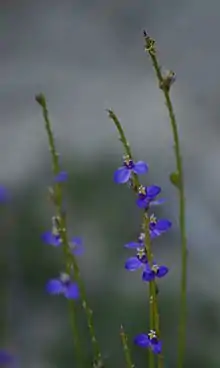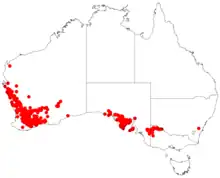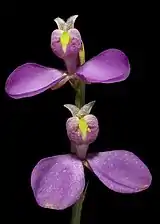| Comesperma scoparium | |
|---|---|
 | |
| Comesperma scoparium at Quairading, Western Australia | |
| Scientific classification | |
| Kingdom: | Plantae |
| Clade: | Tracheophytes |
| Clade: | Angiosperms |
| Clade: | Eudicots |
| Clade: | Rosids |
| Order: | Fabales |
| Family: | Polygalaceae |
| Genus: | Comesperma |
| Species: | C. scoparium |
| Binomial name | |
| Comesperma scoparium | |
 | |
| Occurrence data from AVH | |
| Synonyms | |
| |
Comesperma scoparium, commonly known as broom milkwort, is a small broom-like shrub of the family Polygalaceae.[2] It usually grows to between 0.3 and 1.2 metres high and produces blue flowers between February and November in its native range.[2]
The species was first formally described by James Drummond in The Journal of Botany in 1840 and given the name Comesperma scoparia,[3] which was later amended to the current name.[1]
The species occurs in the states of Western Australia, South Australia, and Victoria in Australia.[4]
Gallery
References
- 1 2 "Comesperma scoparium". Australian Plant Name Index (APNI), IBIS database. Centre for Plant Biodiversity Research, Australian Government, Canberra. Retrieved 24 February 2010.
- 1 2 "Comesperma scoparium". FloraBase. Western Australian Government Department of Biodiversity, Conservation and Attractions.
- ↑ Drummond, J. (1840). Hooker, W.J. (ed.). "XIX. Botanical Information". The Journal of Botany. 2: 369–370.
- ↑ "Comesperma scoparium". Electronic Flora of South Australia Fact Sheet. State Herbarium of South Australia. Retrieved 4 January 2021.
This article is issued from Wikipedia. The text is licensed under Creative Commons - Attribution - Sharealike. Additional terms may apply for the media files.
.jpg.webp)
